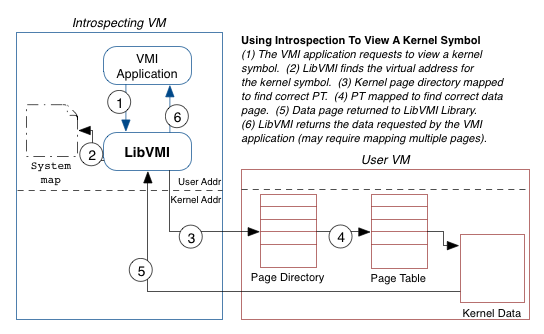Introduction to LibVMI
About LibVMI
LibVMI is an introspection library focused on reading and writing memory from virtual machines (VMs). For convienence, LibVMI also provides functions for accessing CPU registers, pausing and unpausing a VM, printing binary data, and more. LibVMI is designed to work across multiple virtualization platforms. LibVMI currently supports VMs running in either Xen or KVM. LibVMI also supports reading physical memory snapshots when saved as a file.
Features
-
Works with Xen (v3.x through 4.1) and KVM (with patch against QEMU-KVM 0.14)
-
Works with physical memory snapshots saved in a file (e.g., VMWare snapshots)
-
Native API in C (LibVMI) and a feature complete wrapper API in Python (PyVMI)
-
Volatility address space plugin enabled running Volatility on a live VM
-
Works with 32-bit and 64-bit Windows and Linux guests (64-bit support in version 0.8 and newer)
-
Read and write arbitrary data from and to memory
-
Access memory using physical addresses, virtual addresses, or kernel symbols
-
Parse kernel symbols dynamically from running Windows kernel while also providing access to symbols from the KPCR table
-
Load Linux kernel symbols from system map file
-
Expose useful address translation functions through API functions to resolve kernel symbols to a virtual address or translate a kernel or user virtual address into a physical address
-
Pause/unpause the VM through an API function
-
Write your introspection code once and have it work across multiple virtualization platforms
Brief Technical Details
Memory introspection is useful because it allows you to monitor (read memory values) and control (write (present tense) memory values) an operating system from a protected location. But this is a difficult task.
Essentially, memory introspection is the process of viewing the memory of one virtual machine from a different virtual machine. On the surface, this sounds rather simple. In fact, Xen even provides a function to facilitate this type of memory access (although KVM does not).
What makes memory introspection difficult, and where LibVMI comes in, is the semantic gap between the two virtual machines. For example, to look up virtual addresses, LibVMI must walk the page tables inside the user virtual machine; however, in order to walk these page tables, LibVMI must first know where the page directory is located. And this location depends on the process address space you are viewing.
The more you think about the process of memory introspection, the clearer the complexities become. One must know a lot of details about the user operating system in order to build these higher levels of abstraction. LibVMI fills this knowledge gap.
Previous research has shown that introspection can be used for a wide variety of security applications, but more ideas are coming out all the time. Using LibVMI, you can quickly experiment with your new ideas and help advance this new and exciting research direction.

History
LibVMI grew out of the XenAccess Project. While XenAccess was focused exclusively on Xen, LibVMI aims to be extensible to a wide variety of virtualization platforms. Furthermore, LibVMI provides a more intuitive API by transparently handling reads and writes across memory page boundaries. You can read more details about XenAccess in our research paper from ACSAC 2007 titled Secure and Flexible Monitoring of Virtual Machines.